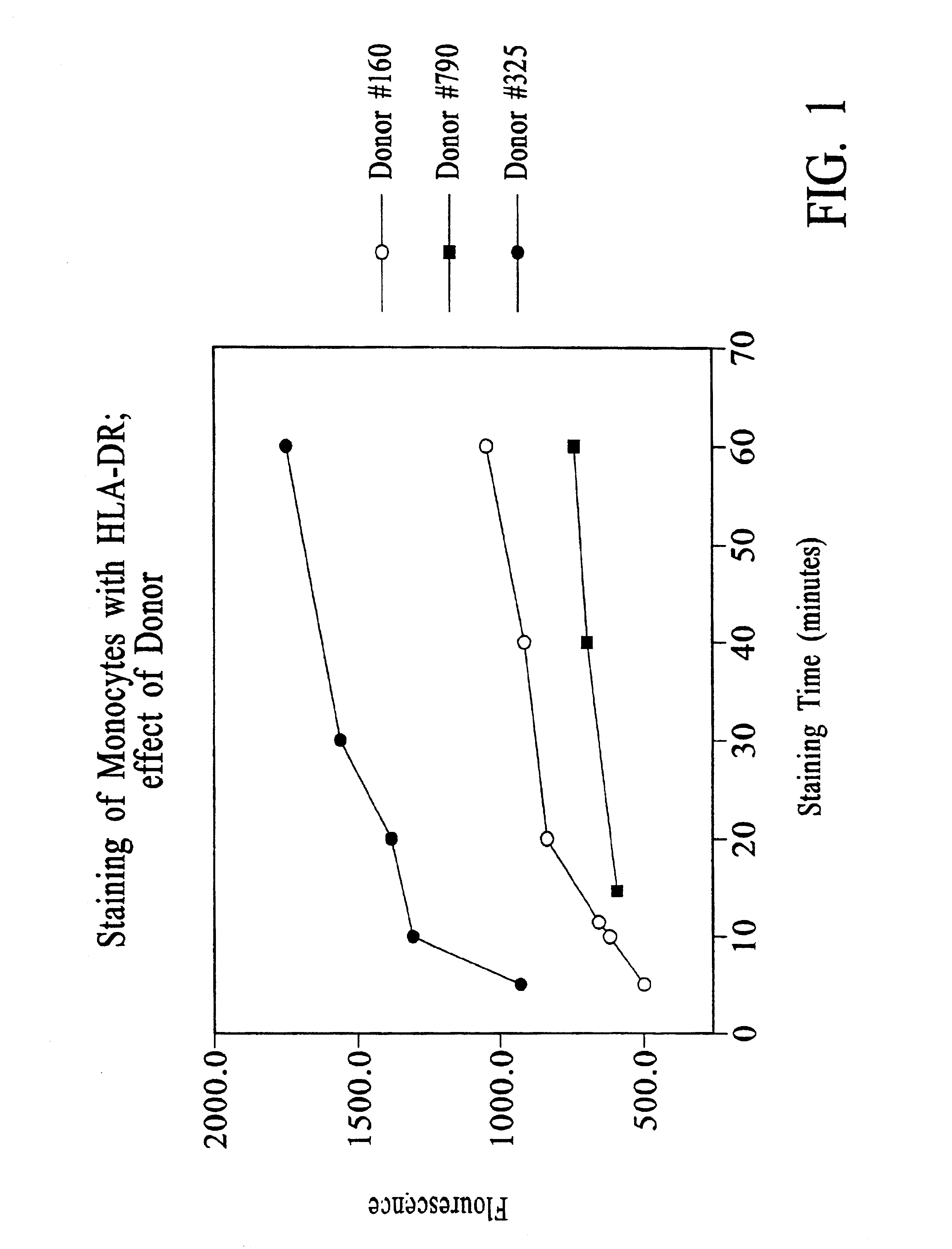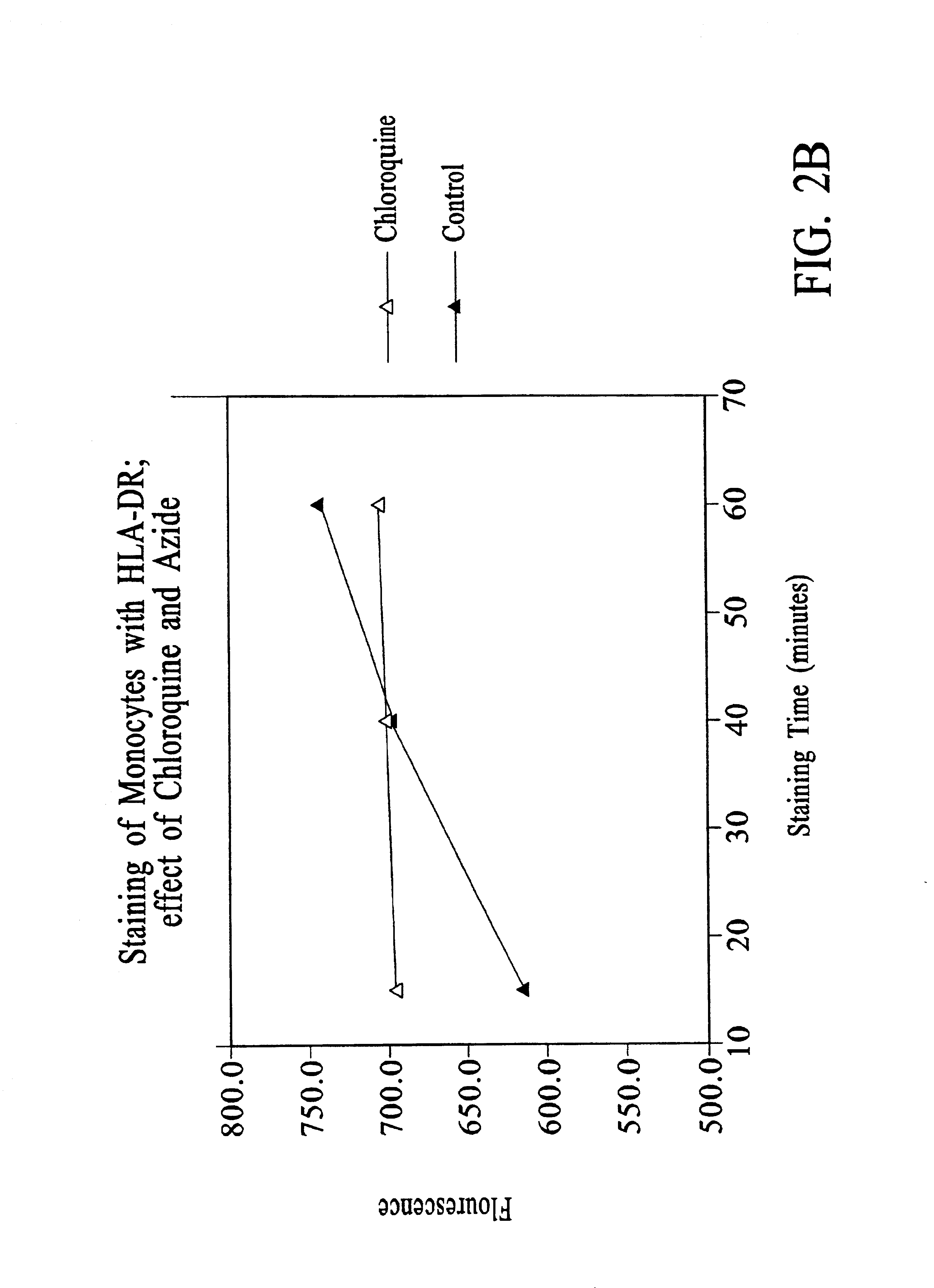Methods and reagents for quantitation of cell-surface molecule expression on peripheral blood cells
a cell surface molecule and reagent technology, applied in the field of methods and reagents for quantitation of cell surface molecule expression on peripheral blood cells, can solve the problems of achieve the effects of high intensity, high uniformity and clustering, and ineffective stabilization of hla-dr expression
- Summary
- Abstract
- Description
- Claims
- Application Information
AI Technical Summary
Benefits of technology
Problems solved by technology
Method used
Image
Examples
example 1
Chloroquine Inhibition of Time-Dependent Variation in HLA-DR-Specific Fluorescent Antibody Staining
[0114]Peripheral blood samples were drawn from normal volunteers.
[0115]The time-dependence of the HLA-DR-specific signal detectable by flow cytometry of antibody-stained peripheral blood monocytes was assessed by varying the duration of antibody staining.
[0116]For the experiments reported in FIG. 1, to 50 μl EDTA-anticoagulated whole blood was added 10 μl of staining reagent containing either (a) CD14PerCP / CY5.5 (63 ng) and HLA-DR-PE (250 ng) (donors #160 and #325) or (b) CD14-PerCP / CY5.5 (63 ng) and HLA-DR-PE (500 ng) (donor #790).
[0117]Samples were incubated with staining reagent at room temperature for the times indicated, after which 1 ml of 1× FACS™ Lysing Solution (10× stock from BDIS, catalog no. 349202) was added, and incubation continued for 10 minutes.
[0118]For donor #160, the samples were then centrifuged at 250×g for 5 minutes, the supernatant removed, the pellet resuspende...
example 2
Measurement of HLA-DR on Patient Peripheral Blood Monocytes
[0133]Peripheral blood samples were obtained by venipuncture from patients admitted to ICU. One aliquot of each sample was assayed using the following protocol.
[0134]To 50 μl of whole blood was added 10 μl of staining reagent containing 50g / ml HLA-DR-PE (clone L243); 6.3 μg / ml CD14-PerCP / CY5.5; and 18 mM chloroquine diphosphate. HLA-DR-PE (BDIS cat. no. 347367, repurified to provide a 1:1 antibody:PE conjugate) is a mouse IgG2a / κ antibody that reacts with a nonpolymorphic HLA-DR epitope and does not cross-react with HLA-DQ or HLA-DP molecules. CD14-PerCP / CY5.5 (BDIS custom conjugate of antibody LeuM3, available unconjugated as BDIS catalogue number 347490) is a mouse IgG2b / K antibody specific for CD14.
[0135]The aliquot was incubated for 25-35 minutes in the dark at room temperature, and then 1 ml 1× FACS™ Lysing Solution (obtained as 10× stock, BDIS catalog No. 349202) was added and incubation continued for 8-10 minutes. The...
example 3
Stabilization of CD11b-Specific Fluorescent Signal by Chloroquine
[0139]Blood from three normal adult donors was collected in standard EDTA Vacutainer® tubes and placed directly on ice. Fifty (50) μl of whole blood was transferred to a tube containing 20 μl of a cocktail of CD11b PE and CD45 PerCP antibodies with or without chloroquine, with the chloroquine-containing tubes having a final chloroquine concentration of 3 mM. Blood was stained for the indicated time at room temperature before addition of 1.0 ml FACS lysing reagent (1×). Flow cytometric analysis was performed essentially as described in Examples 1 and 2. Results are shown in FIG. 7.
PUM
| Property | Measurement | Unit |
|---|---|---|
| pH | aaaaa | aaaaa |
| fluorescent | aaaaa | aaaaa |
| molar ratio | aaaaa | aaaaa |
Abstract
Description
Claims
Application Information
 Login to View More
Login to View More - R&D
- Intellectual Property
- Life Sciences
- Materials
- Tech Scout
- Unparalleled Data Quality
- Higher Quality Content
- 60% Fewer Hallucinations
Browse by: Latest US Patents, China's latest patents, Technical Efficacy Thesaurus, Application Domain, Technology Topic, Popular Technical Reports.
© 2025 PatSnap. All rights reserved.Legal|Privacy policy|Modern Slavery Act Transparency Statement|Sitemap|About US| Contact US: help@patsnap.com



